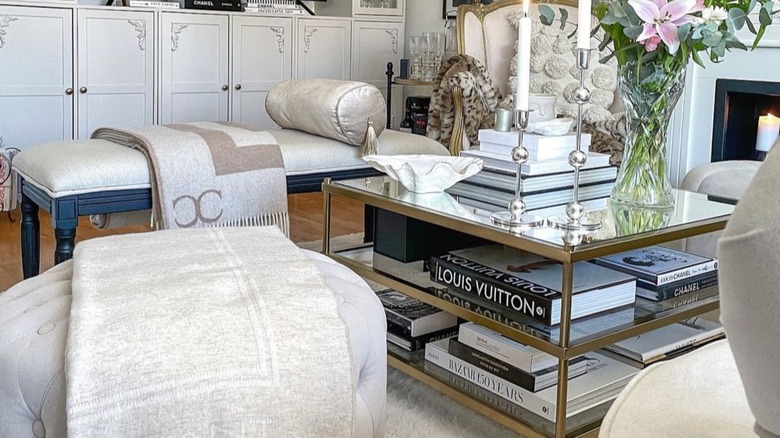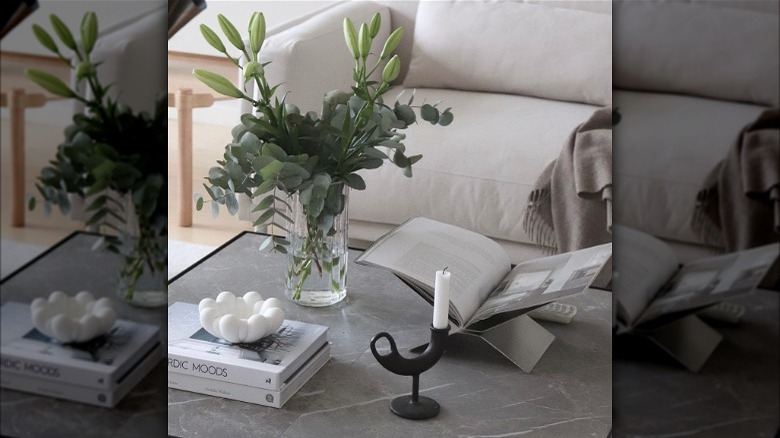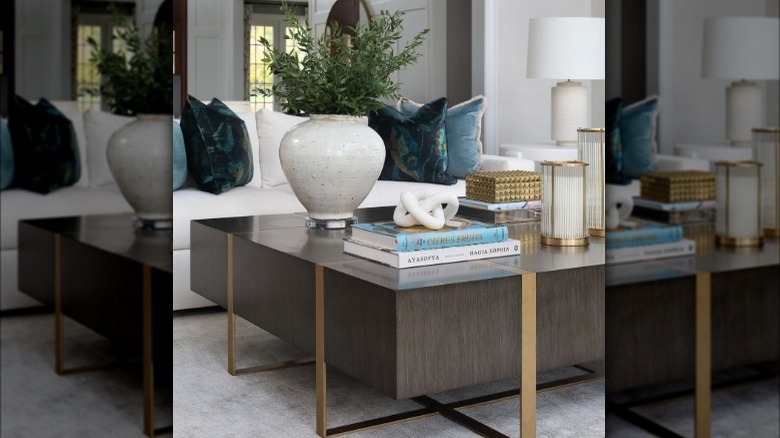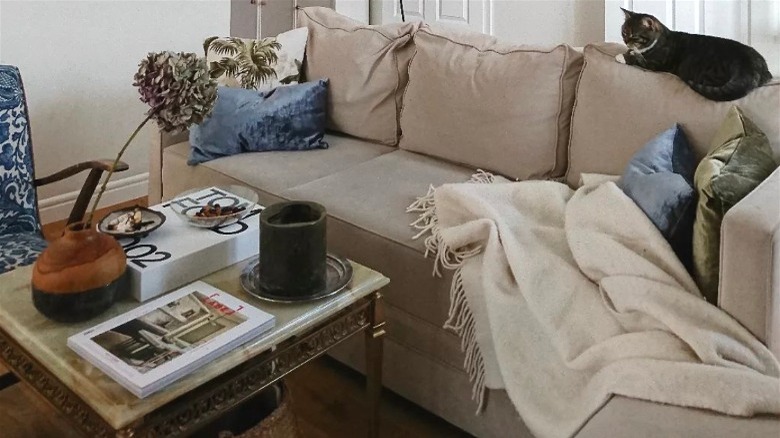This Coffee Table Styling Hack Is One You Have To Try
The perfect coffee table is a functional piece of furniture that can be used to hold snacks, drinks, lit candles, and stocking feet for starters. Yet, when not thus occupied, the flat expanse calls out for some decoration. While that can mean practically anything from glass vases to wood bowls to metal sculptural décor, balance is key. Too much stuff leaves no space for the necessary items, yet too little feels lacking. That's where coffee table books offer a perfect solution. And we like them how we like our jewelry and sandwiches — stacked.
By adding height, color, and a casual and comforting (but definitely chic) library vibe, coffee table books work just right as a display. Finnish designer Johanna Lehmuskallio said in Homes & Gardens, "Beautiful coffee table books [act as] interior design elements just like vases, blankets, or sofa cushions, while telling about the decorator's interests. They bring color and individual style to the interior." Additionally, the intentional piles are a conversation starter and a cure for boredom. Surely flipping through pages instead of scrolling through content is better for us, right?
Another plus with relying on books as décor is there is no trend they cannot match. Whether grand millennial, maximal, farmhouse, cottagecore, dark academia, modern, or rustic, there are books for the aesthetic and the subject. Further, any room is enhanced by a subtle yet insistent reminder of the bounty to be found within their pages.
Books as décor
According to Book Riot, showcasing books as artful arrangements cannot be claimed as a contemporary idea. Volumes were already a popular item to gift and/or display by the mid-1800s, and they were frequently made more elaborate and embellished for the purpose. Centuries later, they're still a decorating classic; at once minimal due to squared edges and uniform shapes, and yet maximal for their towering stacks, striping spines, and the plethora of concepts represented. Books can be curated to create a particular style; for example, neutral linen covers and fewer, wider stacks lend a different feeling than rainbow dust jackets stretching to great heights.
Fashion anthologies, travelogues, and publications featuring photography, paintings, and gardening inspiration make the ultimate coffee table books because they tend to include gorgeous covers and stunning large format plates. Generally, these books are oversized, helping to build an ample (low effort) display quickly. It's nice to choose one to leave open at an arresting image, rotating through the collection; certain plates might connect us to a season, holiday, or activity.
"A few large coffee table books with a pretty accessory on top and fresh flowers is an easy and inexpensive way to dress up a coffee table," said interior designer Seyie Putsure in Homes & Gardens. Stacked books act as a podium for highlighting smaller specialty items like a bud vase, lacquered tray, lidded vessel, brass candlesticks, giant shells, or a paperweight. They're easily adjusted and arranged to make a well-proportioned design.
Book stacking etiquette
When stacking, place the biggest books at the bottom for stability, and remember that an accumulation of books can become exceedingly weighty. If that's a concern, pile some underneath your coffee table as well. Depending on the table's design, this may even visually balance the display, ensuring the table doesn't seem top-heavy. Lifestyle blogger Lilian at That Isle Life is partial to using books as décor because they're kid-friendly; they pose no risks (aside from toppling and paper cuts), they're too big to swallow, and they won't break into sharp pieces. Further, they're affordable, especially when purchased at a library sale or second-hand shop. However, it's important to note that books printed before the 1950s may contain hazardous amounts of lead in the printing inks and painted covers, per Lead Safe Mama.
If you love your books, but not the way they look, consider releasing them from their temporary dust jackets or replacing those with handmade paper covers. Who knew a simple project we remember from grade school could make such an aesthetic impact? Socialite and columnist Emily Post did; she taught her readers how to disguise their unattractive books beneath faux jackets. As such, the practice of "bookaflage" was born as a way to promote a more polished facade to anyone stopping by for a visit (via Book Riot). It's an ideal way to elevate budget finds, conceal torn bindings, or protect from sun fading and other damage.
Choosing the right books
Havenly suggests occasionally swapping featured volumes to complement an updated color palette or reflect a seasonal change in our interiors. Similarly, they can be shifted as our interests transform. The advantages of books on display are two-fold; not only are they visually appealing, but as previously mentioned, the titles and subjects hint at our personalities and experiences, making them even more compelling home décor. "Identity display is the primary motivation for strategically displaying books," explained environmental psychologist, Paul Harris, Ph.D., in Architectural Digest. "We know that others judge us based on our surroundings and we attempt to shape those judgments when decorating our homes." Just a minute while we remove, ... er, rearrange our favorite tomes.
Surely, as we turn a new page (the book puns abound) to personal and comfort-driven interior design styles, we care less about how we appear to others and more about how (and with what and whom) we are filling our days and our homes. "Coffee table book stacks are much more interesting when they are different sizes so they can be stacked so that all the titles are visible. And though large books create visual impact, I would suggest stacking up books simply because you love them," noted Lucy Searle in Homes & Gardens. They beautify our living rooms, and they also inform and affirm our desired environment. Books offer a textural and tactile nudge toward our own story.



